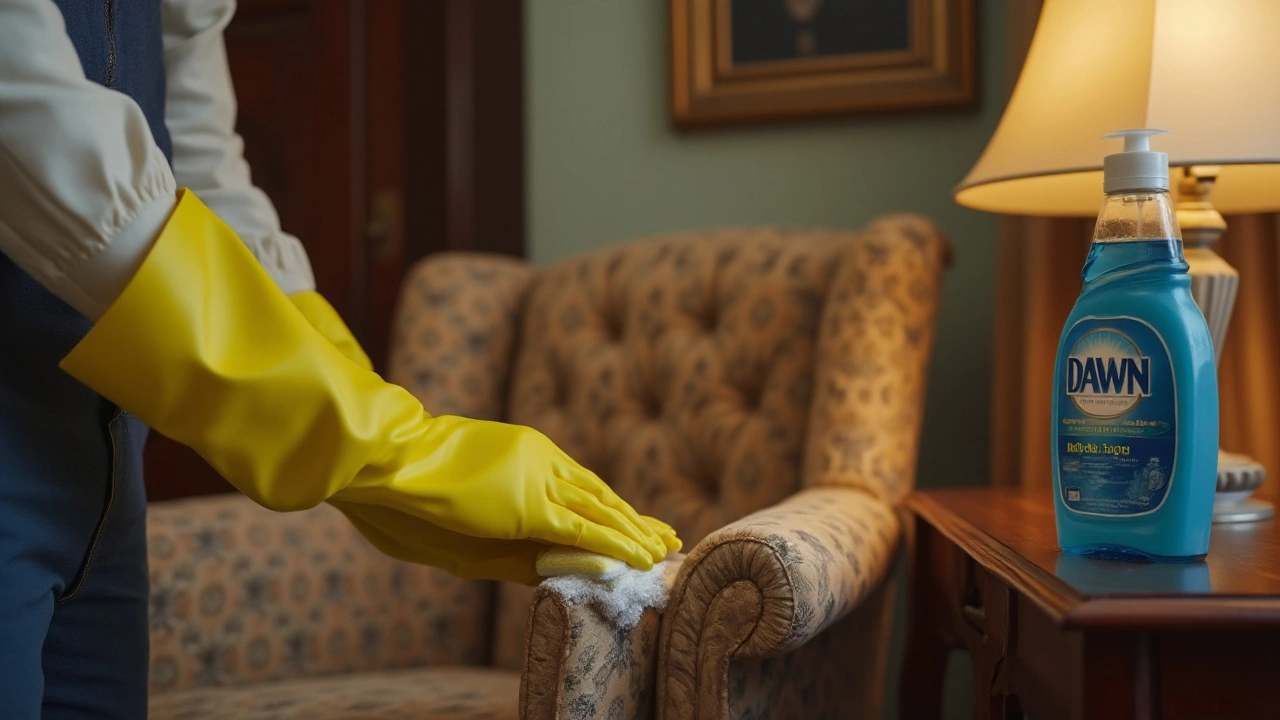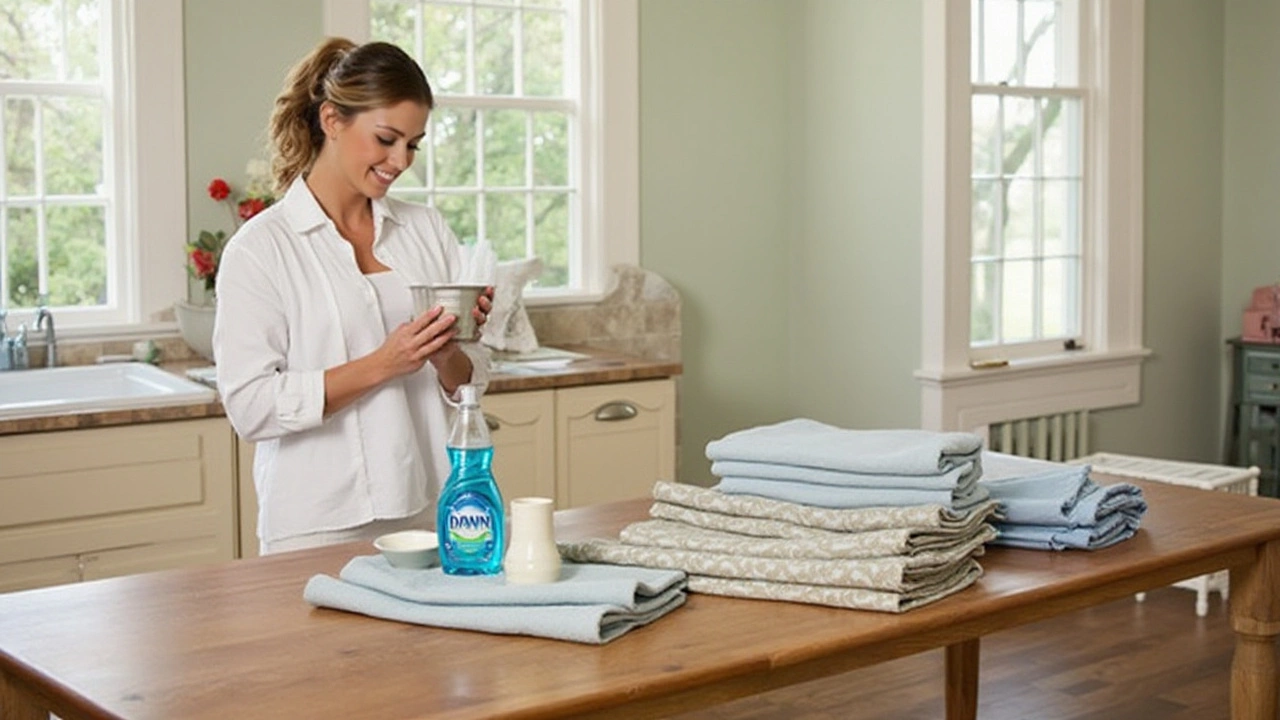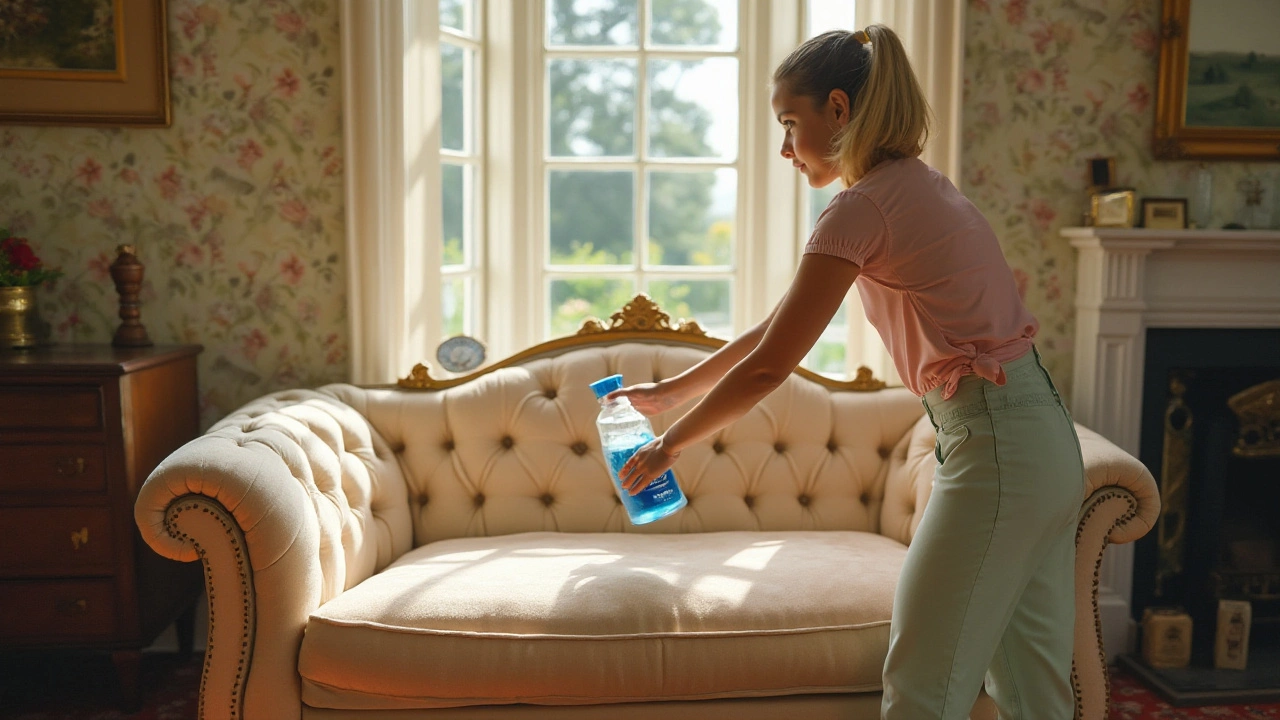Keeping upholstery clean can often feel like an uphill battle, with stubborn stains and daily dirt making their presence known. Interestingly, one of the most effective solutions might already be sitting on your kitchen counter – Dawn dish soap. Renowned for its grease-fighting abilities, this household staple isn't just for dishes anymore.
In this article, we'll journey through the science behind Dawn soap and its unexpected yet effective role in upholstery maintenance. You'll learn simple preparation steps, discover easy application techniques, and understand helpful safety tips to protect your furniture's fabric while ensuring it looks its best. Let's dive into the world where this seemingly ordinary soap unveils its versatility and perhaps saves you a costly professional cleaning service.
Dawn Soap Properties
When it comes to household cleaning products, few have as stellar a reputation as Dawn soap. Its origins date back to the 1970s, and over the decades, it has carved out a niche for its unparalleled grease-cutting abilities. What makes it stand out among various cleaning agents is its unique combination of surfactants. These compounds work by surrounding dirt particles and lifting them away from surfaces—an attribute particularly useful for cleaning tough grime and stains. The blend of detergents is mild yet effective, which is why it’s often safe to use on more than just dishes.
One notable ingredient in Dawn soap is sodium lauryl sulfate, known for its effectiveness in breaking down oils and fats. This component plays a crucial role in its ability to tackle even the greasiest of residues, rendering it a go-to choice for upholstery cleaning. Sodium chloride, a simple salt, is another component that helps thicken the soap, giving it the right consistency for various applications. The formula is balanced to be tough on stains yet gentle enough not to damage surfaces permanently, making it perfect for both kitchen dilemmas and upholstery challenges.
The versatility of Dawn soap is augmented by its concentration. A little goes a long way, sparing your budget while extending its use from simple dishwashing to advanced cleaning ventures. When diluted correctly, it can tackle a multitude of stains without leaving behind any residue or causing discoloration. Its popularity isn't just grounded in anecdotal evidence; the soap's efficacy has been backed by scientific studies and user testimonials. As
Larry Reynolds, a prominent chemist in household cleaning, once noted, "The molecular makeup of Dawn beer soap is such that it defies conventional limitations of what liquid detergents are meant to do."
It's worth noting that the brand does pride itself on more than just cleaning power. Apart from being efficient, Dawn soap exhibits attributes that are environmentally considerate. This environmental awareness includes the development of biodegradable options and formulas free from phosphates, decreasing its ecological footprint. Such considerations make it a conscientious choice for those mindful of sustainability alongside cleanliness. While it shines in the kitchen, its gentle touch extends to various materials and surfaces, offering a comprehensive solution for cleaning enthusiasts who seek both performance and planet-friendly options.
Preparing Your Upholstery
Before diving into the cleaning process with your trusty Dawn soap, it’s crucial to prepare your upholstery adequately to ensure the best results. The first step is to understand the material you’re working with. Different fabrics react differently to various cleaning agents, even to something as gentle as dish soap, so pulling out that furniture tag and reading the care instructions should be your starting point. Many fabrics are tagged with codes like 'W,' 'S,' 'WS,' and 'X,' indicating the type of cleaners appropriate for them. For instance, 'W' indicates that water-based cleaners are safe to use, making Dawn a suitable choice, while 'S' means you have to opt for solvents.
Next, a thorough vacuuming session is in order. Using your vacuum cleaner’s soft brush attachment, meticulously go over every nook and cranny of the furniture. This step helps remove loose dirt, dust, and debris which could turn into a muddy mixture when wet. This preliminary cleanup not only prevents spreading more dirt during the washing phase, but also gives you a clearer view of stained areas that need more attention. Plus, it helps avoid the dirt from getting embedded deeper into the fabric when moisture is applied.
"Vacuuming before cleaning is the golden rule of upholstery maintenance," says Jane Collins, a noted interior cleaning expert. "By doing this, you're clearing the path for a more effective wash and less need for abrasive scrubbing that could harm your upholstery."
Once dirt and excess grime have been removed, consider performing a spot test. Choose an inconspicuous area of the upholstery and apply a small amount of Dawn diluted with water. This step is crucial in observing how the fabric reacts to the soap solution. Look out for any discoloration, texture changes, or shrinking when the solution is applied and after it dries. This little test can save a lot of grief and stress over potential damage.
While preparing your upholstery for a thorough de-greasing and stain-fighting session, don't overlook the power of strategic sunlight exposure. Fresh air and light can brighten fabrics naturally and contribute to odor removal. However, avoid prolonged exposure which could lead to fading or color loss, especially with bright or deeply colored fabrics. With your upholstery adequately prepared, it's time to bring out that bottle of Dawn soap and begin the satisfying journey to fresher furniture.

Cleaning Techniques
Cleaning upholstered furniture with Dawn soap is more than just a straightforward scrub-and-rinse procedure. It requires a delicate balance of careful technique and patience to achieve the best results. To start, always begin with a small inconspicuous spot on your furniture. This patch test helps ensure that the color and fabric remain undamaged when introduced to the soap solution. A safety check can save you from any unpleasant surprises later on.
Once you've confirmed the area is safe, mix a cleaning solution. Add one teaspoon of Dawn soap to a small bowl of warm water, stirring gently to create suds. Avoid creating excess foam, as it can be challenging to rinse out later. Make sure not to drench the fabric, which might lead to watermarks or overly damp cushions that take a long time to dry. Instead, aim for a lightly damp, manageable mix.
"You need to be careful not to oversaturate the material," advises Jane Smith, a textile cleaning expert. "A little goes a long way, and patience is key to keeping your upholstery looking new."
Now, dip a soft, clean cloth into the solution. Squeeze out any excess liquid to prevent dripping. Gently blot the stain rather than rubbing it, as this technique lifts the dirt without allowing it to soak further into the upholstery. Continuous, light movements work wonders in breaking down grease and sticky residues without damaging the fibers.
After blotting, use a separate cloth dampened with plain water to rinse the soap residue from the fabric. Excess soap can attract dirt over time, so it's crucial to ensure all traces are removed. This rinse cycle prevents sticky build-up and keeps your upholstery fresh and inviting. Take a moment to appreciate the improvement you're likely to see after just this simple application.
Drying the Surface
Once cleaned, the upholstery should be allowed to dry naturally. Open windows for ventilation or use fans if you need to speed up the process. Avoid using heat lamps or hair dryers as these can warp or shrink certain materials. In fact, allowing natural air drying ensures even drying across the surface, minimizing any risk of accidental damage.
Remember cleaning isn't just about erasing stains. Regular maintenance with tools like a vacuum can reduce the frequency with which deeper cleaning is required. Consistent care and strategic use of Dawn soap can significantly extend the life of your furniture, sparing you frequent professional services. These techniques are not only practical but economical.
Safety Tips
When using Dawn soap for upholstery cleaning, safety should always be at the forefront of your mind. Despite its gentle formulation for dishes, this mighty cleaning agent may carry risks if not handled correctly, especially on delicate fabrics. Firstly, it's crucial to begin with a spot test. Choose an inconspicuous area of the upholstery and apply a small amount of the soap mixed with water. This step ensures no adverse reactions occur, such as discoloration or fabric weakening. Remember that different fabrics react differently, so testing beforehand can save much distress.
Another aspect to consider is the soap-to-water ratio. A highly concentrated mix might yield undesirable effects, like fading or leaving soap residues that attract more dirt over time. Typically, a mixture of one teaspoon of Dawn soap in a cup of lukewarm water suffices for most cleaning needs, balancing cleaning efficiency without risking damage.
Ventilation is a quiet hero in the cleaning process, often overlooked. Although Dawn soap isn't heavily perfumed, prolonged exposure in a confined space can lead to irritation for some individuals. Open windows or employ a fan to circulate air, ensuring that fumes are not inhaled excessively during cleaning. Also, wearing gloves can be a simple precautionary measure, shielding sensitive skin from dryness or irritation caused by repeated contact with the concentrated soap solution.
As you work through those persistent stains, using a soft brush or cloth is advisable. Gentle tools prevent the wearing out of fabric fibers, maintaining the furniture's integrity. It's important not to soak the material; excess moisture can seep into inner layers, leading to mold or mildew if not thoroughly dried. Hence, keep a towel handy to blot out excess water post-cleaning.
"Safety isn't expensive, it's priceless," said Jerry Smith, an expert from the American Cleaning Institute.
Pay attention to rinsing. After tackling the stains, it's vital to rinse the area with clean water to remove soap residues. Lingering soap can make fabrics sticky, warranting more frequent cleanings. Notably, child or pet-friendly spaces demand extra diligence, as ingesting any residues can pose health risks.
Finally, ensure the upholstery dries completely before use. This step is pivotal in preventing odors and microbial growth. One practical tip is to use a hairdryer in a cool setting to expedite drying without overheating the fibers. Keep these safety tips in your cleaning arsenal, and you will find upholstery cleaning with Dawn both safe and effective.

Alternative Uses
Delving into the world of household cleaning reveals some surprises, and Dawn dish soap's versatility is one of them. While it's highly effective for cleaning upholstery, its utility stretches far beyond just fabric care. This unassuming soap, often tucked away under your sink, holds the kind of potential that makes it a favorite among cleaning enthusiasts. For instance, it can be transformed into a reliable tool for tackling grease stains not only on dishes but on clothing as well. Using a small amount of warm water and Dawn soap on a stubborn grease spot can often do the trick to loosen and lift the stain. The next time you spill some oil on your favorite shirt, you might find Dawn to be your best ally in making it disappear. Another area where Dawn excels is floor cleaning, particularly for tiles and linoleum. Mixing a few drops of this soap with a bucket of water creates a powerful cleaning solution that leaves surfaces shining. By cutting through grime effortlessly, Dawn helps you maintain a spotless floor without harsh chemicals.
Let's not forget the outdoors, where Dawn's powers can extend to garden care. A mixture of water, Dawn soap, and vinegar is known to work wonders as an insecticidal solution, eliminating pesky insects from your plants without harming them. Gardeners have been using this concoction for years to great success, saying it keeps plant leaves vibrant and pest-free. There is a kind of satisfaction in using a simple product to address varied needs, almost like wielding a multi-tool. Perhaps one of the lesser-known but equally important uses of Dawn soap involves wildlife conservation. Dawn has played a crucial role in cleaning animals affected by oil spills, with organizations worldwide lauding its ability to gently remove oil from feathers and fur. Its importance in environmental rescue efforts underscores how a product from our kitchen proves critical in saving wildlife.
"I often recommend Dawn to my clients for various household challenges," said Maria Evans, a renowned cleaning expert. "It's gentle yet effective, making it ideal for everyday use without damaging the surfaces."
For those who like DIY projects, Dawn can be integrated into homemade household cleaners with other natural ingredients. Combining it with baking soda and vinegar can create an all-purpose scrub capable of tackling bathroom grime or kitchen counters. The key is its grease-fighting strength, which, when paired with other elements, becomes a comprehensive cleaning solution. Experimenting with these combinations can lead to cost-effective and eco-friendly alternatives to commercial products. There's a simple joy in exploring these alternative uses, realizing how a modest dish soap can make life easier and more sustainable. It's not just about finding shortcuts but embracing smarter, safer ways to keep our homes and beyond in pristine condition.
